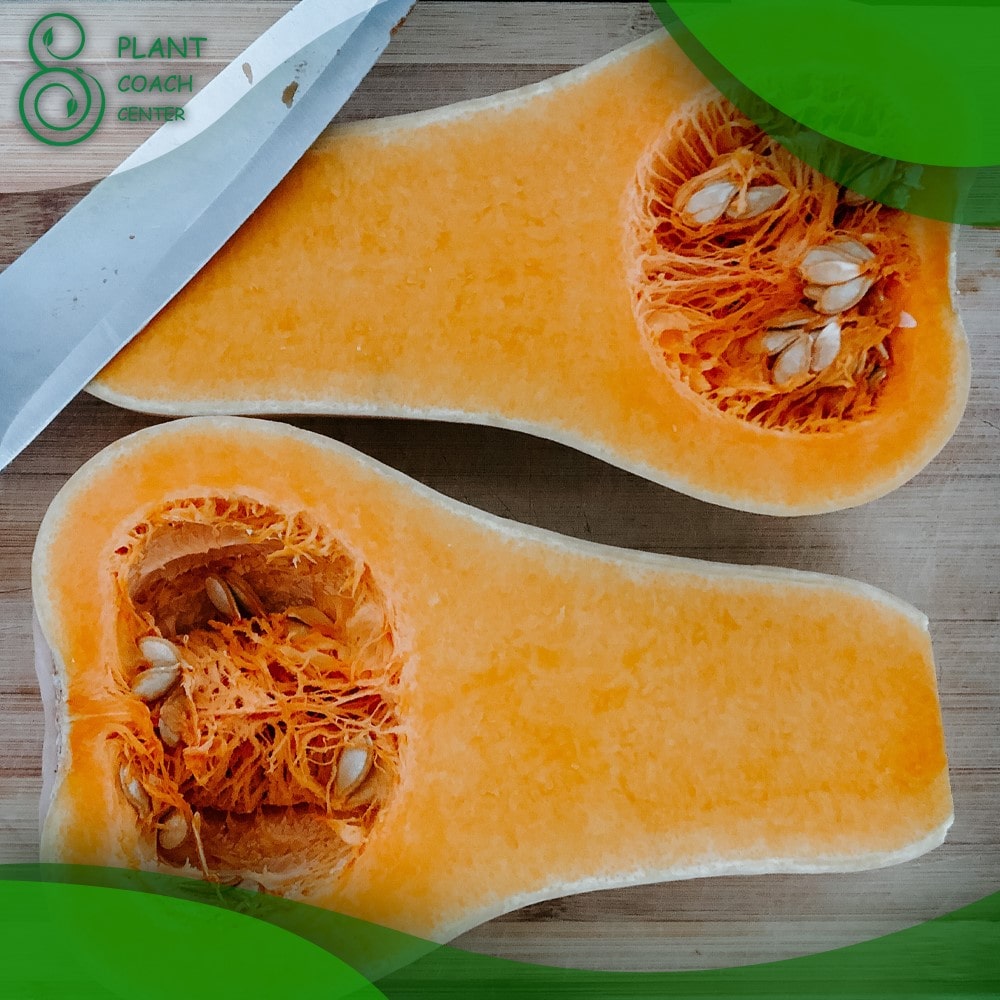When to Plant Spaghetti Squash
Plant coaching plays a crucial role in maximizing plant growth and addressing common plant problems. In this comprehensive guide, we will explore the topic of plant coaching in relation to spaghetti squash cultivation. We’ll cover the ideal planting time for spaghetti squash, growth requirements, troubleshooting common problems, and tips for maximizing yields.

Spaghetti Squash Overview
An Introduction to Spaghetti Squash
Spaghetti squash, scientifically known as Cucurbita pepo, is a popular winter squash variety. It gets its name from the unique stringy flesh that resembles spaghetti strands when cooked. It is a nutritious and versatile vegetable with a range of culinary uses.
Nutritional Benefits of Spaghetti Squash
Spaghetti squash is a nutrient-dense vegetable that offers various health benefits. It is low in calories and carbohydrates while providing essential vitamins, minerals, and dietary fiber. Incorporating spaghetti squash into your diet can support weight management, improve digestion, and boost nutrient intake.
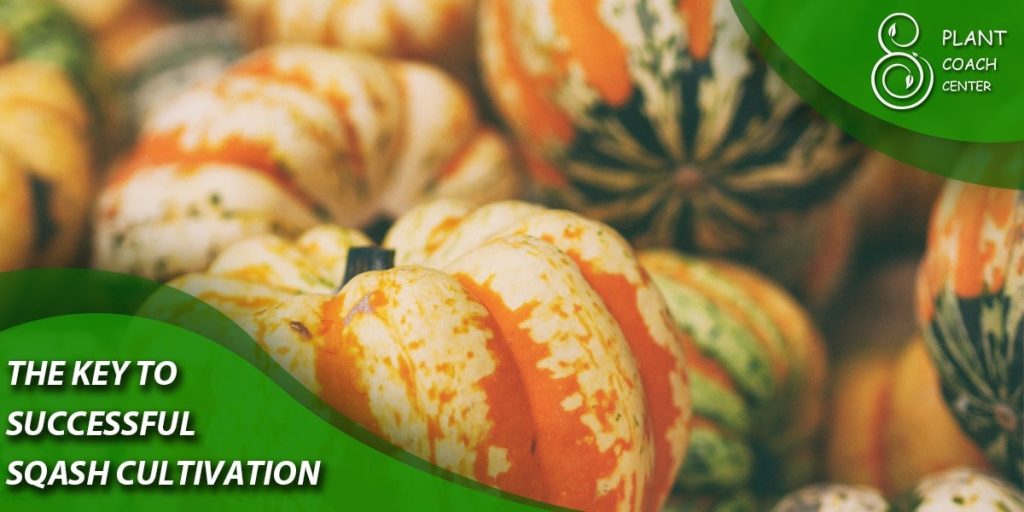
Plant Coaching: The Key to Successful Squash Cultivation
What is Plant Coaching?
Plant coaching involves personalized guidance and support provided by plant coaches or gardening experts. They assist growers in optimizing plant health, implementing best practices, and troubleshooting problems throughout the growing season. Plant coaching helps ensure successful plant growth and abundant yields.
The Role of Plant Coaches in Maximizing Plant Growth
Plant coaches play a vital role in assessing individual plant needs, creating customized care plans, and monitoring plant progress. They provide guidance on various aspects such as planting schedules, soil preparation, watering techniques, pest management, and disease prevention. With their expertise, plant coaches empower growers to achieve optimal results.
Benefits of Plant Coaching for Spaghetti Squash
Engaging with a plant coach when cultivating spaghetti squash can offer numerous benefits. They can provide insights into specific requirements for spaghetti squash, recommend suitable varieties, offer guidance on planting time, and assist in troubleshooting common issues like pest infestations and diseases. Plant coaches help growers navigate challenges and increase the likelihood of a successful harvest.
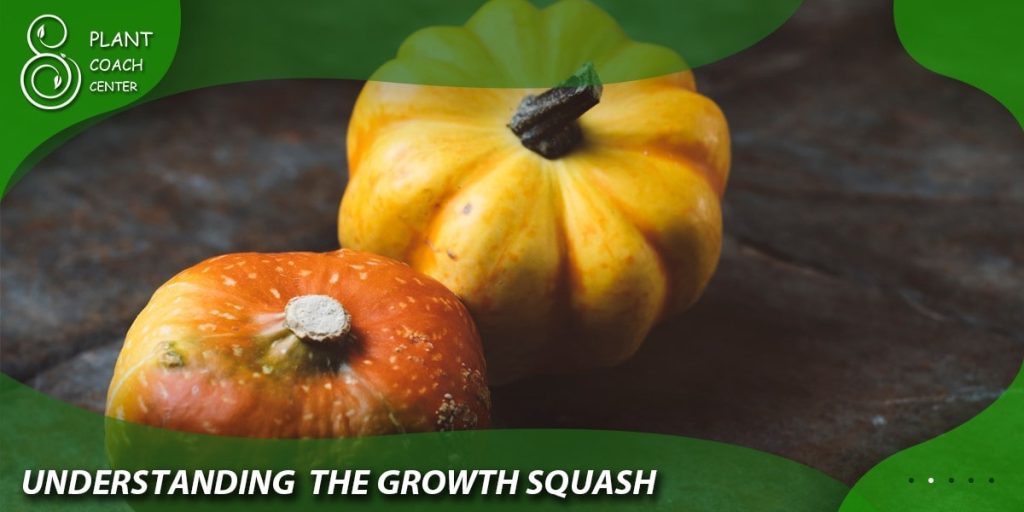
Understanding the Growth Requirements of Spaghetti Squash
Environmental Factors for Spaghetti Squash Growth
Successful spaghetti squash cultivation requires attention to key environmental factors. Consider the following aspects:
Temperature Requirements
– Spaghetti squash thrives in warm weather conditions with temperatures between 70-85°F (2-29°C).
– Wait until the soil temperature reaches at least 60°F (5°C) before planting to promote optimal germination and growth.
Sunlight and Photoperiod Considerations
– Spaghetti squash requires full sun exposure, ideally 6-8 hours of direct sunlight per day.
– Ensure that the planting location receives adequate sunlight throughout the day to support healthy plant development.
Soil Conditions and pH Levels
– Spaghetti squash prefers well-draining soil rich in organic matter.
– The ideal soil pH for spaghetti squash ranges from 6.0 to 6.8. Conduct a soil test to determine pH levels and amend the soil accordingly.
Moisture and Watering Needs
– Spaghetti squash plants require consistent soil moisture, but be cautious not to overwater.
– Water deeply once a week, providing approximately -.5 inches of water, depending on rainfall and soil conditions.
Determining the Ideal Planting Time for Spaghetti Squash

Understanding your local climate and frost dates is essential for determining the optimal planting time for spaghetti squash. Consider the following steps:
. Research your region’s average last spring frost date and first fall frost date. These dates serve as a guideline for planting and harvesting.
. Take into account the specific requirements of spaghetti squash, considering its sensitivity to cold temperatures.
. Plan your planting schedule to ensure that spaghetti squash has enough time to mature before the first fall frost.
Calculating Growing Degree Days for Spaghetti Squash
Growing degree days (GDD) provide a measure of accumulated heat and help determine the right planting time. Follow these steps:
. Determine the base temperature for spaghetti squash. Typically, it is around 50°F (0°C).
. Track daily average temperatures during the growing season, starting from when the soil reaches the desired planting temperature.
. Calculate the cumulative GDD by subtracting the base temperature from the average daily temperature and summing up the values over time.
. Refer to spaghetti squash’s specific GDD requirements to identify the optimal planting time based on accumulated heat units.
Using Phenological Indicators to Determine Planting Time
Phenological indicators, such as the appearance of certain plant or insect species, can provide valuable cues for planting spaghetti squash. Some indicators include:
– Monitor the blooming of specific flowers or the emergence of pests that coincide with favorable planting conditions.
– Consult local gardening resources or plant experts to identify reliable phenological indicators for your region.
By combining information from climate data, GDD calculations, and phenological indicators, you can determine the most suitable time to plant spaghetti squash in your area.
Preparing for Spaghetti Squash Planting
Seed Selection and Quality Assessment
Selecting high-quality seeds is crucial for successful spaghetti squash cultivation. Consider the following tips:
– Purchase seeds from reputable suppliers or save seeds from healthy, open-pollinated spaghetti squash fruits.
– Check the seed packet or supplier’s information for details on variety, days to maturity, and any specific growing requirements.
– Inspect the seeds for uniform size, intact shells, and no signs of damage or decay.
Preparing Seed Starting Containers and Soil Mixes
Starting spaghetti squash seeds indoors gives them a head start before transplanting. Follow these steps:
. Use biodegradable seed starting containers or trays with drainage holes to prevent waterlogging.
. Fill the containers with a well-draining soil mix rich in organic matter, such as a combination of compost, peat moss, and vermiculite.
. Moisten the soil mix before sowing the seeds to ensure proper moisture levels.
Soaking Spaghetti Squash Seeds: Pros and Cons
Soaking spaghetti squash seeds before planting can offer certain benefits:
– Soaking can help soften the seed coat, promoting faster germination.
– It may increase the germination rate and uniformity of seedling emergence.
– Soaking can help identify any non-viable seeds that float to the surface.
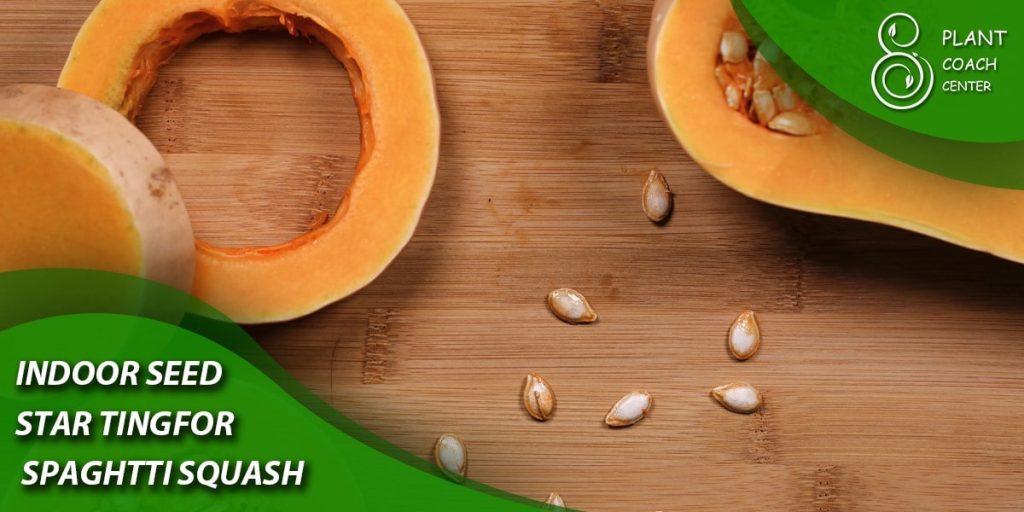
Indoor Seed Starting for Spaghetti Squash
Step-by-Step Guide to Starting Spaghetti Squash Seeds Indoors
Starting spaghetti squash seeds indoors allows for controlled conditions and early establishment. Follow these steps for successful indoor seed starting:
. Sow the seeds in the prepared containers, following the recommended spacing and depth indicated on the seed packet.
. Place the containers in a warm and well-lit area, preferably near a south-facing window or under grow lights.
. Maintain consistent moisture by watering the soil when it feels slightly dry to the touch. Avoid overwatering, as it can lead to damping-off disease.
. Provide gentle air circulation by using a small fan or by lightly brushing your hand over the seedlings once they emerge. This helps strengthen the plants.
. When the seedlings develop their first true leaves, thin them if necessary, keeping the strongest and healthiest plants.
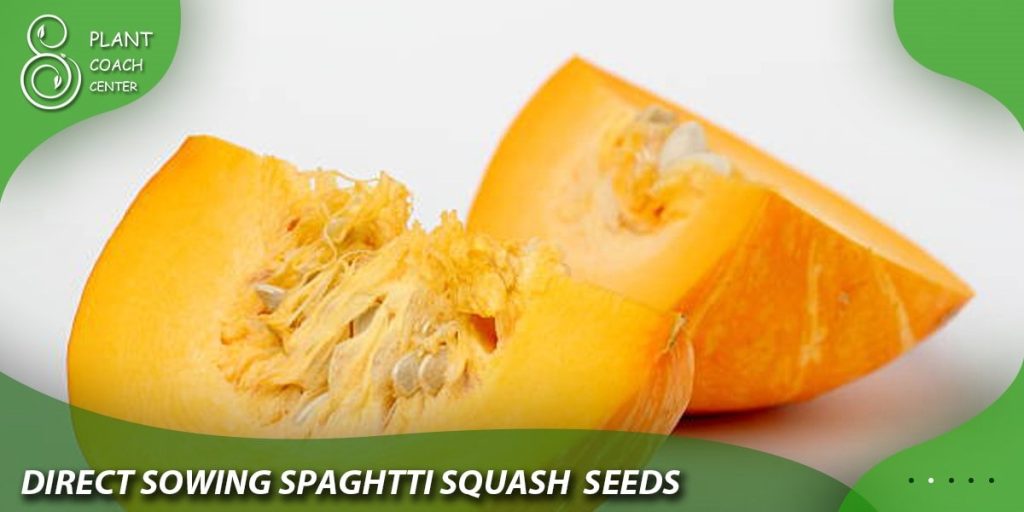
Direct Sowing Spaghetti Squash Seeds in the Garden
Preparing the Garden Bed for Direct Sowing
Before direct sowing spaghetti squash seeds, prepare the garden bed accordingly:
– Choose a sunny location with well-draining soil and amend it with organic matter, such as compost or well-rotted manure.
– Remove any weeds, rocks, or debris from the planting area.
Proper Spacing and Depth for Planting Spaghetti Squash Seeds
Follow these guidelines for optimal spacing and planting depth when direct sowing spaghetti squash seeds:
– Space the seeds or seedlings approximately 4-6 feet apart in rows that are 8-2 feet apart. This provides sufficient room for the sprawling vine growth.
– Plant the seeds at a depth of around inch (2.5 cm) in the soil.
Mulching and Weed Control Strategies for Squash Beds
Mulching and weed control are essential for maintaining a healthy spaghetti squash bed:
– Apply a layer of organic mulch, such as straw or wood chips, around the plants to help conserve moisture and suppress weed growth.
– Regularly inspect the bed for weeds and remove them promptly. Be cautious while weeding to avoid damaging the squash plants’ shallow roots.
Troubleshooting Common Spaghetti Squash Problems
Identifying and Treating Pests
Pests can pose challenges to spaghetti squash plants. Here are some common pests and their management strategies:
Squash Bugs: Prevention and Control
– Inspect plants regularly for the presence of squash bugs and remove them by hand when spotted.
– Use floating row covers to protect young plants from squash bug infestations.
– Encourage natural predators, such as ladybugs and lacewings, to control squash bug populations.
Cucumber Beetles: Management Strategies
– Monitor plants for cucumber beetle activity and use sticky traps to catch and control them.
– Introduce beneficial insects like parasitic wasps or predatory beetles to help control cucumber beetle populations.
Vine Borers: Detection and Remedies
– Keep a close eye on the base of the squash plants for signs of wilting or entry holes, which indicate vine borer activity.
– Use preventive measures like applying floating row covers or aluminum foil collars around the base of the plants to deter vine borers.
– If vine borers are present, carefully remove them with a knife and mound soil over the damaged area to encourage new root growth.
Managing Diseases in Spaghetti Squash
Spaghetti squash is susceptible to certain diseases. Here are some common diseases and their management:
Powdery Mildew: Prevention and Treatment
– Provide adequate spacing between plants for proper air circulation and sunlight penetration.
– Apply organic fungicides or homemade solutions, such as neem oil or baking soda spray, to control powdery mildew.
Bacterial Wilt: Symptoms and Control Measures
– Monitor plants for wilting leaves, yellowing, and bacterial ooze.
– Remove and destroy infected plants to prevent the spread of the disease.
Fungal Infections: Identification and Management
– Maintain proper plant spacing and avoid overhead watering to minimize conditions favorable for fungal infections.
– Apply fungicides labeled for use on squash plants, following the instructions carefully, to control fungal diseases.
Maintenance and Care Tips for Spaghetti Squash
Watering Practices for Spaghetti Squash
Proper watering is crucial for healthy spaghetti squash plants. Consider the following tips:
– Water deeply once a week, providing approximately -.5 inches of water, depending on rainfall and soil conditions.
– Water at the base of the plants, avoiding foliage to minimize the risk of diseases.
– Use a drip irrigation system or soaker hoses to deliver water directly to the root zone.
Fertilization and Nutrient Requirements
Spaghetti squash plants have specific nutrient requirements for optimal growth. Follow these guidelines:
– Conduct a soil test to assess nutrient levels and pH. Amend the soil as needed based on the test results.
– Apply a balanced fertilizer, such as a 0-0-0 or 4-4-4 formula, before planting and again when the plants start flowering.
– Consider using organic fertilizers or compost to provide slow-release nutrients to the plants.
Supporting Vines and Controlling Growth
Spaghetti squash vines can grow quite long and benefit from proper support and control:
– Install trellises, cages, or stakes to support the vine growth and prevent sprawling.
– Train the vines to grow along the supports, gently guiding them as they grow.
– Regularly prune or redirect the vines to maintain manageable growth and prevent overcrowding.
Harvesting Spaghetti Squash
Knowing when to harvest spaghetti squash is crucial for obtaining the best flavor and texture. Follow these guidelines:
– Monitor the squash regularly and look for signs of maturity, such as a deep, even color and a hard rind that resists puncture.
– Use a sharp knife or pruning shears to cut the squash from the vine, leaving a short stem attached.
– Harvest before the first fall frost, as exposure to cold temperatures can damage the squash.
Storing Spaghetti Squash
Proper storage helps extend the shelf life of harvested spaghetti squash:
– Cure the squash in a warm, dry place for about 0-4 days to allow the skin to harden and flavors to develop.
– Store the cured squash in a cool, dry area with good ventilation. Ideal temperatures range from 50-55°F (0-3°C).
– Check stored squash regularly for any signs of decay or rot, and use any damaged squash promptly.

Conclusion
Plant coaching plays a vital role in successful spaghetti squash cultivation. By understanding the ideal planting time, growth requirements, and common problems associated with spaghetti squash, growers can maximize their yields and enjoy a bountiful harvest.
Engaging with a plant coach or gardening expert can provide personalized guidance and support throughout the growing season, helping you overcome challenges and achieve optimal results in your spaghetti squash garden.
Remember to visit PlantCoachCenter.com for more information and resources on plant coaching and gardening tips.


